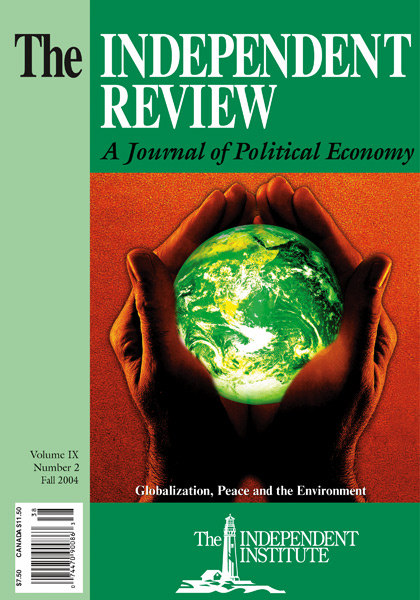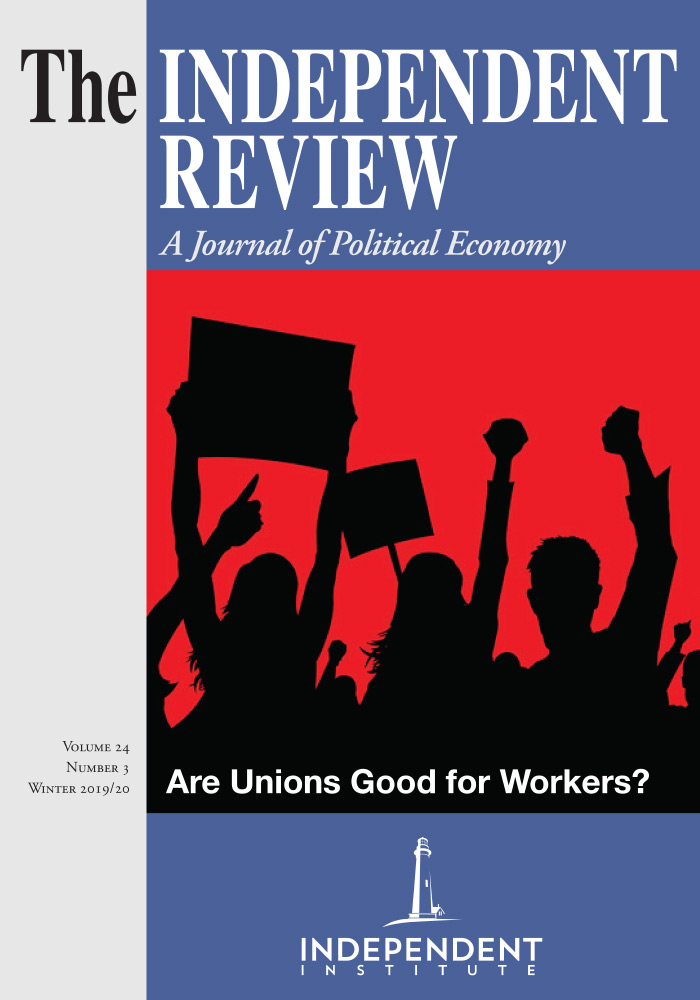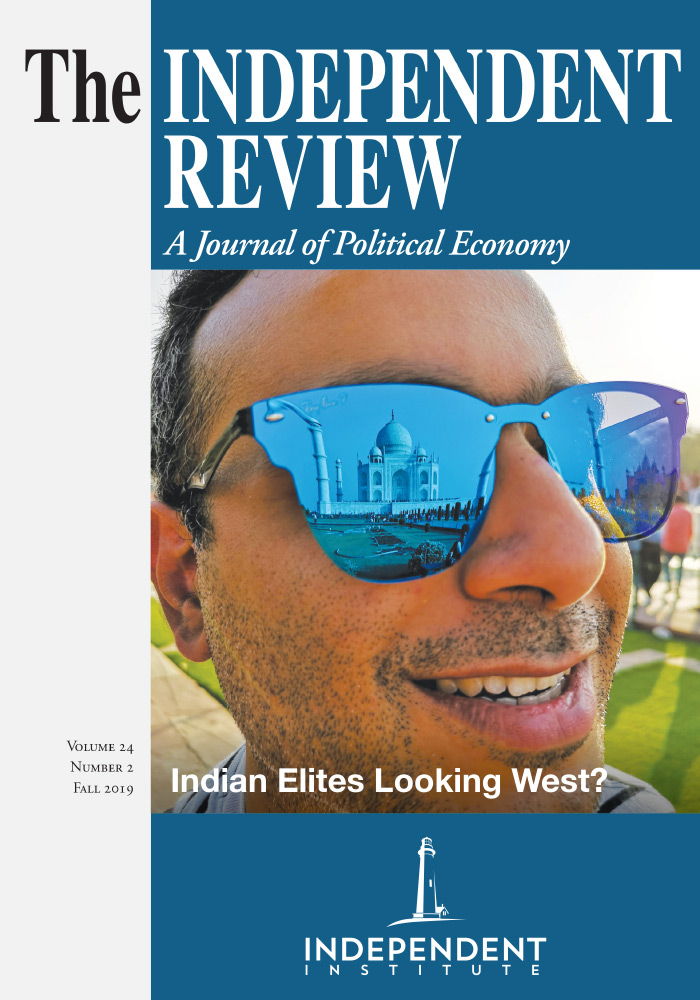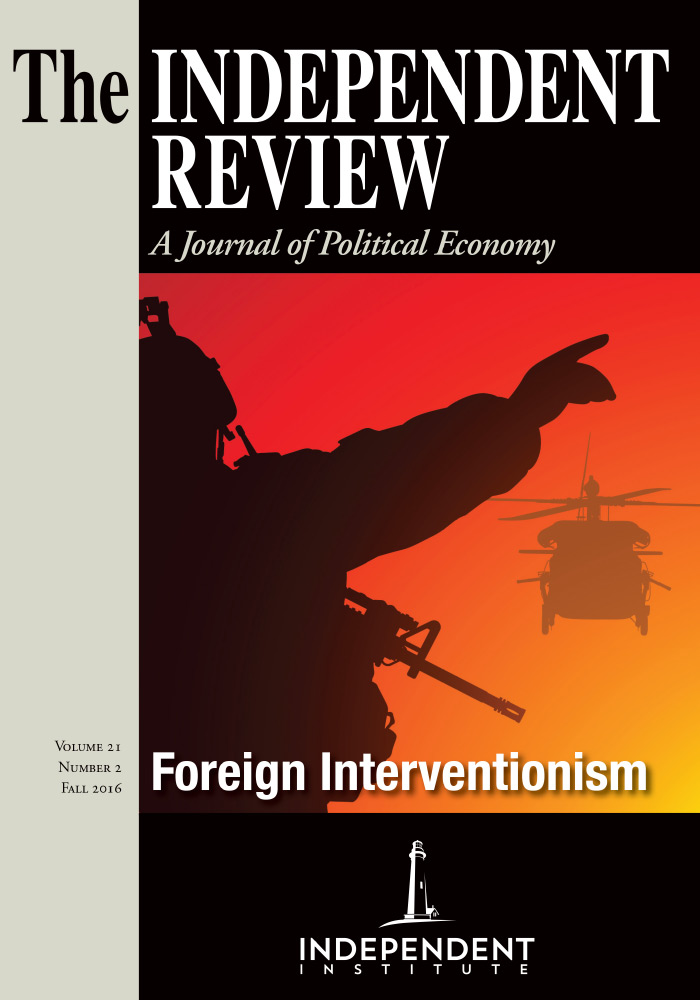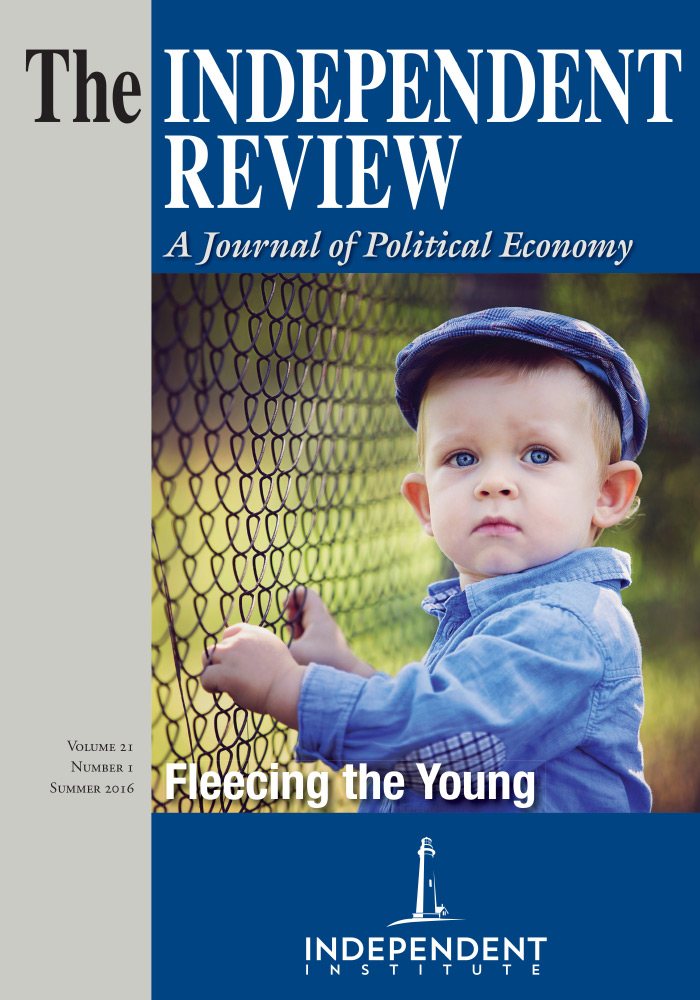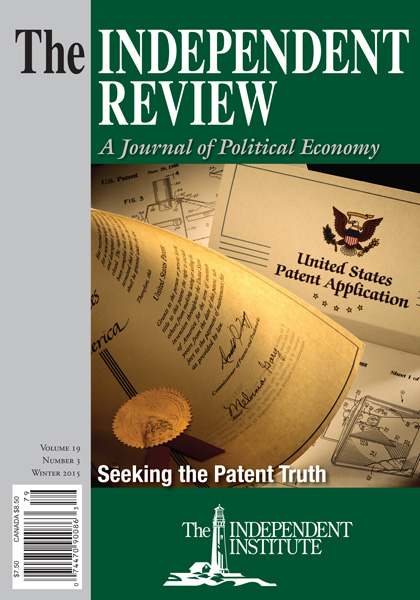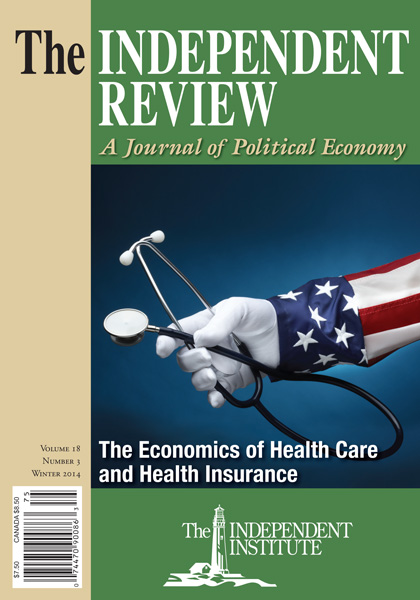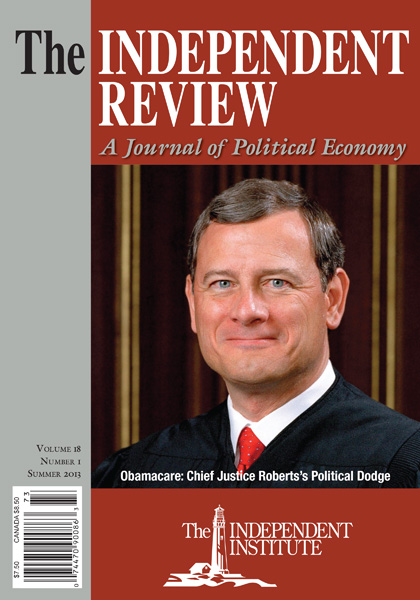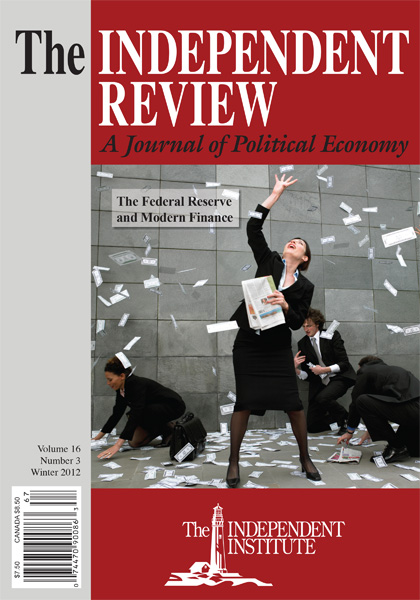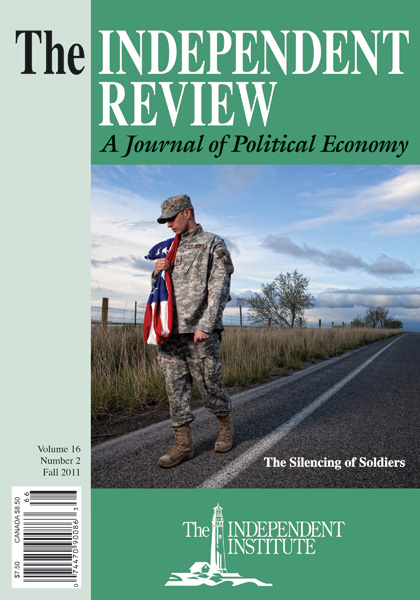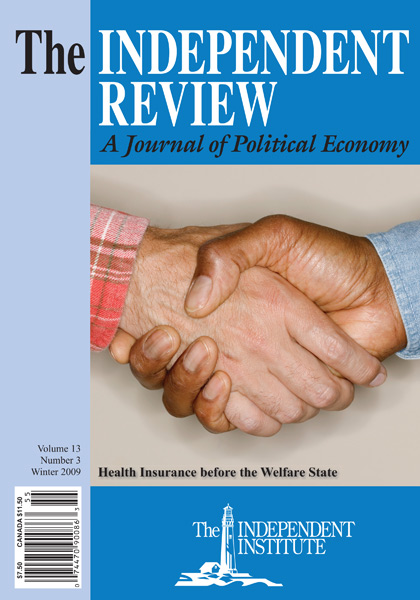Critics of globalization forget that free trade fosters prosperity and know almost nothing about its most important benefit—its tendency to prevent war. Quantitative studies have shown that trade fosters peace both directly, by reducing the risk of military conflict, and indirectly, by promoting prosperity and democracy.
Article
Capitalism and economic freedom promote peace. Globalization can be understood as a process of market expansion and market integration, as the universalization of capitalism. After a short discussion of the political economy of globalization, I turn to the frequently overlooked security benefits of globalization. The diffusion of prosperity, free trade, and democratization is part of the story. Quantitative studies provide a great deal of evidence for a causal chain running from free trade via prosperity and democracy to the avoidance of military conflict, as well as for another causal relationship between trade or economic openness and conflict avoidance. After a review of the quantitative literature and a discussion of some methodological issues, I illustrate the capitalist peace by historical examples and contemporary applications. At the end, I consider how the capitalist peace may be “exported” from Western societies to poor and conflict-prone nations and regions.
The Political Economy of Globalization
The process of globalization had already begun in the late nineteenth century. Before World War I, trade and foreign investment were fairly globalized. Because of low political obstacles to international migration, labor markets actually were more globalized at the beginning of the twentieth century than at its end. The two world wars and the Great Depression between them interrupted the process of global market integration for about half a century. Thereafter, the process regained force and speed. Now, inexpensive, fast, and reliable communication and transportation enable producers of goods and some service providers in low-wage countries to challenge high-cost producers in rich countries on their home turf, but technological innovation resulting in falling prices and rising speed of intercontinental communication and transportation is not the only determinant of globalization. Political decisions in rich and poor countries alike contribute strongly to globalization, too. Tariffs and, to a lesser degree, nontariff barriers to trade have been reduced. Many countries try to find and exploit their comparative advantage, to realize economies of scale and gains from trade by looking for buyers and sellers everywhere. If trade between countries is truly free, then it promises to enrich all nations.
Since the publication of Adam Smith’s Wealth of Nations ([1776] 1976), we have known that the size of the market limits the division of labor and that the division of labor boosts innovation and productivity. In principle, globalization is the logical endpoint of the economic evolution that began when families switched from subsistence farming and household production to production for the market. As long as globalization is not yet completed-and it certainly is not yet-gains from trade remain to be realized by further market expansion. Because globalization adds to competitive pressure, however, it causes resentment, and because globalization springs from technological innovation and political decisions that promote free trade, these innovations and decisions attract resentment, too. The world is already globalized enough that national resistance does limited damage. Except for the United States, national resistance is more likely to contribute to a country’s decline than to derail the process of globalization.
Free trade is vulnerable. If foreigners are perceived as a cause of the need to adjust, then attacking free trade becomes politically attractive. After all, no politician benefits from the affection of foreigners who cannot vote. Of course, economists who insist on the benefits of free trade (even if your trading partner does not practice free trade) are right. Benefits include serving customers better at lower prices, but also faster growth of total factor productivity (Edwards 1998; OECD 2003, 89). The benefits of free trade, however, tend to be dispersed widely, whereas its costs (for example, certain bankruptcies and job losses) tend to be concentrated and more visible. Therefore, the political case against free trade may become very strong despite the weakness of the economic argument.
Who in rich Western societies is affected most by globalization? Although unskilled labor is much less expensive in poor countries than in rich countries, this difference does not necessarily provide poor countries and poorly paid labor there with a competitive advantage. Frequently, even unskilled labor is much more productive in rich countries than in poor ones. If the wage gap is neutralized by a countervailing productivity gap, unit labor costs are not affected by international differences in pay. If unskilled labor in rich countries is overpaid compared to unskilled labor in poor countries, however, then free trade reduces the demand for rich-country labor that is used intensively in the production of importable goods—that is, for low-skilled labor used in producing goods that compete with Western imports. The wages of low-skilled Western workers may suffer from downward pressure because their services have become more easily substitutable than previously (Rodrik 1997). This process might result in growing volatility of earnings and income inequality, as in the United States, or high unemployment, as in much of Continental Europe. Of course, unemployment is most likely to result from a combination of fierce international competition and rigid labor markets at home. Otherwise, trade is more likely to affect the composition of employment than its amount (Irwin 2002, 71).
Analysts dispute the degree to which either trade or technological progress has caused the predicament of unskilled labor in the West. Although the majority view (for example, Krugman 1996) blames most of it on technological progress, this conclusion is not entirely satisfying because technological progress is frequently inferred from estimated production-function residuals rather than from direct measurement. An outspoken minority (for example, Wood 1994, 166-67) puts most of the blame on free trade and estimates that approximately 9 million manufacturing jobs might have been lost in rich countries by 1990 and many more by now. The complementary gain of 23 million jobs in poor countries may satisfy humanitarian impulses, but it does not help Western politicians to win elections. In the past three years, one out of six manufacturing jobs has been lost in the United States (“Flying on One Engine” 2003, 30). Although trade is almost certainly not the primary determinant of this job loss or of increased wage inequality (Irwin 2002, 99), some Americans look for scapegoats. Because China has a larger trade surplus with the United States than even Japan does, China bashing has become popular in America.
With regard to the expansion of economic freedom and secure property rights, globalization provides reason for hope. Globalization ties politicians’ hands and prevents them from pursuing politically attractive but self-defeating policies, such as those that created the welfare state and its disastrous effects on incentives to produce goods or services for others. As Vanberg has observed, “competition among jurisdictions offers citizens and jurisdiction-users effective protection against exploitation, be it in favor of privileged groups or of those who hold the reigns of political decision-making power” (2000, 106). Where markets are significantly larger than political units, stifling the markets by political controls and by undermining economic freedom becomes more difficult than elsewhere. In my view (Weede 1996, chap. 4, and 2000, inspired by Jones 1981), even the rise of the West and the comparative stagnation of the great Asian civilizations until the mid- or late twentieth century is owing to political fragmentation and disunity in Europe in contrast to the huge centralized empires in China, India, or the Middle East. Capital and even labor to a lesser degree could exit from oppressive rule in the West, thereby mitigating its incidence. By contrast, Asian emperors or sultans were not forced to respect the property rights of merchants and producers.
Because globalization may require Western welfare states to accept either widening income inequality or high unemployment (given their fairly rigid labor markets), protectionism remains a politically attractive cure. In politics, competition does not guarantee a movement toward greater efficiency or economic freedom. For special interests—owners and workers of enterprises threatened by foreign competition, and politicians willing to serve them rather than the much bigger, but silent constituency of consumers—academic support may be crucial in legitimating their claims (Bhagwati 1991, 6). Even if material well-being were one’s only concern, it would be extremely important to resist the protectionist temptation. Protectionism harms consumers, reduces the speed of wealth-enhancing structural change, and diminishes opportunities for employees to move to better-paid jobs producing for global markets.
The Security Benefits of Globalization
A Survey of Empirical Studies
Although neither “realist” theorizing about interstate politics (Waltz 1979; Mearsheimer 2001) nor critical treatments of globalization (Gray 1998; Kapstein 1999) recognize it, a strong and beneficial link exists between globalization and the avoidance of war. In my view, the economic benefits of globalization and free trade are much less important than the international security benefits. The quantitative literature (summarized by Weede 1996, chap. 8, and 2000, chap. 11) comes fairly close to general agreement on the following four propositions from economics, political sociology, and international relations.
First, democracies rarely fight each other (Russett 1993; Russett and Oneal 2001). This finding does not necessarily imply that democracies fight fewer wars than do other regimes. It is even compatible with the view widely shared until recently that the risk of war between democracies and autocracies might be even higher than the risk of war between autocracies. I agree with critics of the democratic peace that we do not yet understand fully why democracies rarely fight each other and whether normative or institutional characteristics of democracies matter most. Explaining the democratic peace between Western democracies as “an imperial peace based on American power” (Rosato 2003, 599) is not justified, however. Admittedly, I held this view thirty years ago (Weede 1975). Then I explained peace among U.S. allies by their common ties or even by their subordination to the United States. Later, however, I discovered that autocratic U.S. allies, in contrast to democratic U.S. allies, fought each other or against democratic U.S. allies, as the football war in Central America and the Falklands War illustrate. Thus, I became a convert to the democratic-peace proposition. John Oneal, in unpublished analyses carried out in Bonn in 2003, found that although the democratic-peace proposition consistently calls the imperial-peace proposition into question, controlling for an imperial peace does not subvert the democratic-peace proposition.
Second, prosperity, or high income per capita, promotes democracy (Burkhart and Lewis-Beck 1994; Lipset 1994; Przeworski et al. 2000; Boix and Stokes 2003; Rajapatirana 2004).
Third, export orientation in poor countries and open markets in rich countries (that is, trade between rich and poor countries) promote growth and prosperity where they are needed most, in poor countries (Greenaway and Nam 1988; Dollar 1992; Edwards 1998; Lindert and Williamson 2001, 37; Dollar and Kraay 2002; Rajapatirana 2004).
Fourth, bilateral trade reduces the risk of war between dyads of nations (Oneal and Russett 1997, 1999; Russett and Oneal 2001). As to why trade contributes to the prevention of war, two ideas come to mind. First, war is likely to disrupt trade. The higher the level of trade in a pair (dyad) of nations is, the greater the costs of trade disruption are likely to be. Second, commerce might contribute to the establishment or maintenance of moral capital (Ratnapala 2003), which has a civilizing and pacifying effect on citizens and statesmen. In the context of this article, however, answering the question of why trade affects conflict-proneness or providing the answer with some microfoundation is less important than establishing the effect itself in empirical research.
Although some writers have questioned or even rejected the “peace by trade” proposition, their criticisms are not convincing. Beck, Katz, and Tucker (1998) raised the serious technical issue of time dependence in the time-series cross-section data, but Russett and Oneal (2001; see also Oneal 2003 and Oneal and Russett 2003b) responded to the objections raised against their earlier work and demonstrated that those objections do not affect their substantive conclusions. For a while, Hegre’s (2000) study seemed to necessitate a qualification of the “peace by trade” proposition. He found that the pacifying effect of trade is stronger among developed countries than among less-developed countries. More recently, however, Mousseau, Hegre, and Oneal corrected this earlier finding and reported: “Whereas economically important trade has important pacifying benefits for all dyads, the conflict-reducing effect of democracy is conditional on states’ economic development” (2003, 300). Gelpi and Grieco (2003) suggested another qualification. In their view, trade no longer pacifies relations between autocratic states. According to Mansfield and Pevehouse (2003), another modification of the “peace by trade” proposition might be required. The institutional setting, such as preferential trade agreements, matters. It is even conceivable that other forms of economic interdependence, such as cross-border investments, exercise some pacifying impact. Foreign direct investment (FDI) certainly promotes prosperity, growth, and democracy (de Soysa and Oneal 1999; de Soysa 2003), but the conceivable pacifying impact of FDI still lacks sufficient empirical investigation.
The most radical criticism comes from Barbieri (2002), according to whom bilateral trade increases the risk of conflict. As outlined by Oneal and Russett (2003a, 2003b; Oneal 2003; Russett 2003), her conclusion results from disregarding the military power of nations—that is, their different capabilities to wage war across considerable distances. Should we really proceed on the presumption that war between Argentina and Iraq is as conceivable as between the United States and Iraq or between Iran and Iraq? Of course, trade has no pacifying effect on international relations wherever the risk of conflict is extremely close to zero to begin with. Even this inadequate handling of the power and distance issue by itself does not suffice to support her conclusions. If the military-conflict variable is restricted to those conflicts that resulted in at least one fatality, then trade is pacifying, whether power and distance are adequately controlled or not. Moreover, Barbieri (2003) herself found some pacifying effect of economic freedom and openness to trade on the war involvement of nations. In spite of the attempted criticism of Russett and Oneal’s findings, the “peace by trade” proposition stands and enjoys powerful empirical support.
Another issue also must be considered. Barbieri’s (2002) measures are based on dyadic trade shares relative to national trade, whereas Russett and Oneal’s measures are based on dyadic trade shares relative to the size of national economies. Gartzke and Li (2003) have demonstrated—arithmetically as well as empirically—that trade shares relative to national trade may rise when nations are disconnected from world trade. Nations may concentrate most of their trade on a few partners and remain rather closed economies. If Barbieri’s and Oneal and Russett’s measures of bilateral trade and their effects are simultaneously considered, then Barbieri’s trade shares exert a conflictenhancing effect and Oneal and Russett’s trade dependence exerts a conflict-reducing effect. This finding of Gartzke and Li’s study not only replicates the substantive findings of both main contenders in the debate about trade and conflict, but it remains robust whether one relies on the Oneal and Russett data or on the Barbieri data, whether one includes all dyads or only dyads for which there is some risk of military conflict to begin with. If one is interested in finding out whether more trade is better or worse for the avoidance of military conflict, then it seems more meaningful to focus on a measure that is related to openness at the national level of analysis, as Oneal and Russett (1997, 1999, 2003a, 2003b; Russett and Oneal 2001) have done, than on a measure that may be high for fairly closed economies, as Barbieri (2002) has done.
Actually, the pacifying effect of trade might be even stronger than the pacifying effect of democracy (Oneal and Russett 1999, 29, and 2003a, 160; Gartzke 2000, 209), especially among contiguous pairs of nations, where conflict-proneness is greater than elsewhere. Moreover, trade seems to play a pivotal role in the prevention of war because it exerts direct and indirect pacifying effects. In addition to the direct effect, there is the indirect effect of free trade as the consequent growth, prosperity, and democracy reduce the risk of militarized disputes and war. Because the exploitation of gains from trade is the essence or purpose of capitalism and free markets, I label the sum of the direct and indirect international security benefits “the capitalist peace,” of which “the democratic peace” is merely a component.1 Even if the direct “peace by trade” effect were discredited by future research, economic freedom and globalization would still retain their crucial role in overcoming mass poverty and in establishing the prerequisites of the democratic peace. For that reason, I (Weede 1996, chap. 8) advocated a capitalist-peace strategy even before Oneal and Russett (1997, 1999) convinced me of the existence of a directly pacifying effect of trade. An Asian statesman understood the capitalist peace intuitively even before it was scientifically documented and established. According to Lee Kuan Yew, “The most enduring lesson of history is that ambitious growing countries can expand either by grabbing territory, people or resources, or by trading with other countries. The alternative to free trade is not just poverty, it is war” (qtd. in “Survey: Asia” 1993, 24).
On Theory and Causality
My survey of the literature may appear vulnerable to a powerful and simple charge. In essence, the quantitative evidence referred to seems to consist of associations between variables and an arbitrary causal interpretation of them. Certainly, one should not infer causation from association or correlation, but this generally accepted insight does not mean that causation and correlation are independent of each other. From my epistemological perspective (influenced by Lakatos 1968–69 and Popper 1959), the proper procedure is the following. Hypothetical causal propositions provide the starting point of empirical research. From such propositions and ceteris paribus assumptions we may deduce which associations, correlations, or regression coefficients between variables to expect—that is, whether the relationship should be positive, zero, or negative. Empirical evidence may either support or contradict our expectations. Although certitude about possession of the truth seems beyond the capabilities of human inquiry, growth of knowledge is conceivable by the successive elimination of errors.
Although an association between the two variables X and Y is equally compatible with the alternative propositions that X causes Y, that Y causes X, that Z causes X and Y—and, conceivably, with more complicated models, too—this argument cannot be generalized to standard multiple-regression models. In general, estimation of partial effects on X and on Y presuppose controlling some other determinants of X that do not affect Y and some other determinants of Y that do not affect X. Taking a partial effect of X on Y as evidence that there is likely to be an equally strong effect of Y on X is not permissible. Of course, the specification of regression equations assumes a causal structure without proving its existence, but final proofs and certainty are not characteristics of empirical science. What is possible is to demonstrate a better or worse fit of propositions and observable reality. Although the evidence adduced in the literature cannot and does not prove that prosperity causes democracy or that dyadic democracy or trade causes peace, this evidence does not support reverse causality, such as democracy causing prosperity or growth, or peace causing democracy or trade. These questions require different research designs from the ones applied in the studies discussed earlier. Therefore, these issues are beyond the scope of this review.
There is also another complication. As illustrated by the debate about the effects of trade and economic interdependence on the avoidance of military conflict, full accordance of empirical studies and verdicts with theories is the exception rather than the rule, if it ever happens at all. Therefore, some philosophers of science (for example, Kuhn 1962 and Lakatos 1968–69) have criticized the idea of falsification and warned against premature rejection of propositions. If “anomalies” or “falsification” are more or less ubiquitous, then our task is no longer simply to choose between theories that have been falsified and therefore deserve rejection and those that are compatible with the facts and therefore deserve to be accepted until evidence against them turns up. Rather, our task is to choose between competing theories—for example, about the conflict-reinforcing or conflict-pacifying effect of trade—and to pick those that fit the data relatively better than others. So the claim advanced in this review of the literature cannot be that the empirical evidence fits the capitalist-peace idea perfectly, but merely that the evidence fits it much better than it fits competing explanations of military conflict and notions about the negative effect of capitalism or the irrelevance of democracy on the avoidance of conflict and war.
Admittedly, the nonexperimental evidence referred to here provides weaker support than experimental evidence in the natural sciences does. In the experimental sciences, two things are under much better control than in the nonexperimental sciences, including econometrics: first, the temporal precedence of presumed causes before their hypothesized effects; and, second, other determinants of the phenomenon under study and their possibly distorting effects. Still, weak or “correlational” evidence is better than none. Moreover, certain precautions are possible and routinely applied in the research discussed here. An association between an independent variable X observed at a certain time and a dependent variable Y observed later provides some support for the proposition that X causes Y, but none for Y causing X. Granger causality tests elaborate on this basic idea and provide further reassurance about the compatibility of causal theory and observable data (see Burkhart and Lewis-Beck 1994 for the prosperity-democracy link and Oneal, Russett, and Berbaum 2003 on the “causes of peace”).
Some Illustrations of the Capitalist Peace
Before discussing illustrations of the capitalist peace, I should consider a standard historical objection against it. Certainly, economic interdependence, including trade, between the Western powers and the central European powers before World War I was quite strong. Nevertheless, World War I occurred. What does this evidence imply about the capitalist peace in general and about “peace by trade” in particular? First, it reminds us that all macropolitical propositions—and certainly those discussed here—are probabilistic instead of deterministic statements. We should always expect exceptions. Second, “peace by trade” is not the only component of capitalist-peace theory applicable here. Another is “peace among democracies.” The democratic character of Germany and its allies before World War I is debatable. By contemporary standards, even the democratic character of the United Kingdom before World War I is not beyond suspicion because of franchise limitations. So World War I is not a clear exception to the democratic component of the capitalist peace. Third, no one should believe that trade and democracy, or the capitalist peace, suffice to explain the presence or absence of military disputes and war. At most, we can claim that “capitalist-peace theory” summarizes some known pacifying effects, but it does not summarize conflict-promoting variables and their effects (Russett 2003). As quantitative researchers documenting the pacifying effects of democracy and trade have found again and again (for example, Oneal and Russett 1997, 1999; Russett and Oneal 2001), power balances matter, too. Before World War I, the balance of power between the opposing coalitions was fairly even. There were no pacifying preponderance effects. Although one cannot claim World War I to be a case demonstrating the value of capitalist-peace theory, neither does it undermine the theory seriously.
It may be argued that the different long-term effects of the settlements of World Wars I and II derive from failure or success in applying a capitalist-peace strategy to the losers of the war. After World War I, France, which determined the peace settlement more than any other nation, failed to promote a capitalist peace. Immiseration and desperation in Germany contributed to Hitler’s ascent to power and indirectly to World War II, in which France had to be saved by its allies. After World War II, the United States pursued a capitalist-peace strategy toward the vanquished and succeeded in making allies out of Germany and Japan.
If the West were afraid of the downside of globalization—that is, its inherent tendency to undermine the status quo and thereby Western or U.S. hegemony—or if the West turned protectionist, then its policies would look like white racism from the outside. Protectionism in the West would condemn many non-Westerners to poverty for longer than unavoidable. Protectionism might turn Huntington’s (1996) “clash of civilizations” into a self-fulfilling prophecy.
Peace by trade is at least as important as peace by democracy. Trade (because of its contribution to prosperity) underwrites democracy and thereby the democratic peace where it prevails. Moreover, it does not suffer from a geopolitical complication that affects peace by democratization. According to the best research, the risk of war between democracies is much lower than elsewhere, but the risk of war between a democracy and an autocracy is higher than elsewhere, at least in recent decades. Although Russett and Oneal (2001, 116) no longer accept this view, I am not convinced that they are correct. To me, findings from a separate analysis of disputes in the Cold War period (Oneal and Russett 1997) look more persuasive than an analysis of data beginning in 1885 that combines relationships from the multipolar pre-World War II period, the bipolar Cold War period, and the beginning of the unipolar period thereafter. Some of the findings reported by Russett and Oneal (2001, 113)—namely, the qualitatively different alliance effects on militarized disputes found in the multipolar and bipolar periods of observation—cast doubt on the wisdom of imposing the same causal structure on different periods of world politics (Gowa 1999).
If we accept, as I do, the idea that democracy causes peace only among democracies, then democratization does not contribute everywhere to peace. Imagine the democratization of a nation located in the middle of a deeply autocratic area. Its democratization would generate a number of autocratic-democratic dyads and thereby increase the risk of war. By contrast, the democratization of a nation surrounded by democracies would certainly be desirable. The democratic peace should first be extended from its North Atlantic core area to contiguous areas. Geographical compactness of the democratic bloc is a prerequisite for the pacifying effects of democracy to apply. Promoting democracy in Poland first and in Uzbekistan much later is not only more desirable, but also more feasible than the reverse order would be. Furthermore, an imposition of democracy in poor and politically unstable countries, as currently being attempted in Afghanistan and Iraq, is at least as likely to produce hostility as democratization and stability.
Israel and Taiwan illustrate the ambivalence of democratization as a tool of pacification. Israel is democratic, but it has been surrounded by autocratic regimes for a long time. Although an autocratic Israel would not necessarily be safe from autocratic neighbors, making a deal between two autocracies—on, say, the Golan Heights—might be easier than making a deal between a democracy and an autocracy. Or, consider Taiwan. Until recently the mainland and Taiwan considered themselves to be parts of China. Now Taiwan is a democracy, and the mainland remains an autocracy. The democratization of Taiwan certainly raised obstacles against an elite deal on unification between two ruling classes.
Fortunately, however, the democratization of Taiwan has already refuted the idea that Confucian or Sinic civilization is incompatible with democracy. If the Chinese economy prospers, if China outgrows poverty, then mainland China may become a democracy in two or three decades. Some promising developments are already observable. Villages elections have been held for about a decade (Rowen 1996). Some cadres already have been voted out of office. In 2003, lowly neighborhood committee leaders were elected in parts of Beijing and other big cities (“A Qualified Vote” 2003, 54). Moreover, China trains more lawyers than before, and the Chinese are beginning to perceive the economic benefits of the rule of law (Pei 1998). Instead of publicly criticizing China’s poor human-rights performance, it seems more effective to support China in joining the capitalist world economy and in establishing some legal foundations for a future transition to democracy that China will voluntarily pursue for the sake of its economic ambitions. As Zakaria observes, “To implement its agreements with the WTO, the government has made wide-ranging reforms of Chinese law, creating stronger economic and civil rights” (2003, 84). By contrast, post-Soviet Russia provides a vivid illustration of the limited value of electoral democracy without the rule of law.
According to Mousseau, Hegre, and Oneal (2003), “peace by trade” in contrast to “peace by democratization” applies regardless of the level of economic development of nations. Moreover, the democratic-peace component of the capitalist peace is constrained by the geopolitical need to avoid leapfrogging in the extension of democracy or tiger-coat patterns of democracy and autocracy. The “peace by trade” component of the capitalist peace, however, suffers from no such limitation. It seems to be a rare case of a desirable end that is attainable by a desirable means. By contrast, protectionism engenders less wealth and more war. Although one might argue that globalization or the resulting inequality destabilizes democracies and promotes internal conflict and violence, there is little empirical evidence to support this view (de Soysa 2003; Fearon and Laitin 2003; Hegre, Gissinger, and Gleditsch 2003; Weede 2003; World Bank 2003).
What Can Be Done to Promote a Capitalist Peace?
Rummel (1994) has pointed out that autocracy—itself frequently the result of rebellion, civil war, and revolution—killed even more people than interstate war, rebellion, or revolution in the twentieth century. Even if an autocratic peace within or between nations should exist—in spite of studies (Peceny, Beer, and Sanchez-Terry 2002; Fearon and Laitin 2003, 85) that call these claims into question—the autocratic cure looks even bloodier than the diseases of war and civil war.2 Therefore, the preservation of democracy where it already exists and the establishment of democracy elsewhere must be part of the solution to the problems of rebellion, political violence, and war. Because the empirical studies discussed earlier have demonstrated some fairly strong effects of democracy on the avoidance of war between democracies, and because the pacifying effects of democracy on rebellion and civil war within states can also be documented (Muller and Weede 1990; Hegre et al. 2001), democracy and democratization are not only ends in themselves but also instruments in combating political violence.3 What can be done to promote and underwrite democracy?
According to Lipset (1994) or Boix and Stokes (2003), the viability of democratic regimes and the likelihood of transitions to democracy depend on the level of economic development. The more prosperous a country is, the more likely it is to become and to remain a democracy. Because this proposition has been supported strongly by cross-national studies, much better than any other conceivable determinant or prerequisite of democracy, we may argue that the promotion of democracy necessitates providing a helping hand to poor countries. This help can be provided in different ways.
First, prosperous countries influence the legal foundations for capitalism or economic policies elsewhere. How much this influence matters was demonstrated during the Cold War by the divided nations, where one part was influenced by the Soviet Union and the other part by the United States. Economies benefiting from U.S. influence, such as West Germany, South Korea, and Taiwan, did much better than East Germany, North Korea, or mainland China, which were inspired by the Soviet model. After China began to abandon socialist practices and converted to creeping capitalism in the late 1970s, it quadrupled its income per capita in two decades and almost closed a sixteen-to-one gap in income per capita with Russia (Weede 2002). The idea of advice should not be conceived too narrowly. By providing a model for emulation, successful countries implicitly provide advice to others. In general terms, the best institutional and policy advice may be summarized as “promote economic freedom” (Berggren 2003; Kasper 2004). Cross-national studies (Dollar 1992; Edwards 1998; Haan and Sierman 1998; Haan and Sturm 2002; Weede and Kämpf 2002) demonstrate that economic freedom or improvements in economic freedom increase growth rates.4 Economic openness or export orientation is part of the package of economic freedom.
Second, prosperous and democratic countries may provide open markets for exports from poor countries. Without a fairly open U.S. market, neither Japan nor the nations of western Europe would have overcome the terrible legacies of World War II as quickly as they did. Without a fairly open U.S. market, the East Asian economic miracles might never have happened. South Korea and Taiwan might still be poor and ruled by autocrats instead of being fairly prosperous and democratic.
Third, rich and democratic countries may provide FDI to poor countries. Even the nominally still communist regime in the People’s Republic of China has understood the importance of FDI. Moreover, FDI not only promotes growth and prosperity, but also directly contributes to democratization (de Soysa and Oneal 1999; Burkhart and de Soysa 2002; de Soysa 2003).
Fourth, rich and democratic countries may provide economic aid. By and large, big economies, such as the United States or Japan, provide relatively much less aid than small Scandinavian economies, such as Norway or Sweden. But barriers to imports from poor countries are the lowest in the United States and the highest in Norway. Whereas European assistance to poor countries is provided by governments for the most part, U.S. private giving may be 3.5 times as large as U.S. official development assistance (Adelman 2003, 9). Rich-country subsidies to agricultural producers, which harm poor countries, are much greater than development aid. Whereas European Union aid per African person is approximately $8 dollars, subsidies per European Union cow are $913 (UNDP 2003, 155–60). The theoretical case for aid, however, has always been weak (Bauer 1981). Aid may strengthen governments and undermine free markets. This risk is much greater with government-to-government aid than with private giving, which rarely selects the state as recipient. Certainly, foreign aid does not promote democracy (Knack 2004).
Econometric studies have not demonstrated that aid generally increases growth rates. In recent studies, one finds either a curvilinear relationship between aid and growth (Hansen and Tarp 2000), which suggests that some aid may be useful but too much of it may be harmful, or a conditional effect, which suggests that positive aid effects depend on a proper policy environment in the recipient nation and that otherwise aid is simply wasted (Burnside and Dollar 2000). Or one finds that the effectiveness of aid depends on its bilateral rather than multilateral character (Ram 2003). Both the ambivalent findings about the effectiveness of aid and the poor record of official aid giving from the biggest Western economies underline that economic development depends above all on domestic efforts, institutions, and policies.
Still, there is some room for beneficial outside influences. The mere existence of prosperous and developed countries generates advantages of backwardness and opportunities for faster growth of less-developed countries (Barro and Sala-i-Martin 1995; Olson 1996; Bleany and Nishiyama 2002). They can borrow technology from the more developed countries and thereby grow faster than the Western pioneers of economic development grew. Japan until the 1960s and the East Asian tiger economies thereafter used these advantages of backwardness effectively. Currently, China, India, and parts of Southeast Asia do so. Catch-up opportunities are enhanced if poor countries invest in human capital for everyone—as China, South Korea, and Singapore have done to a much greater degree than India and Indonesia have (Drèze and Sen 1995)—if they follow an export-oriented development strategy, if they welcome FDI, and if prosperous Western economies provide open markets for poor countries and their products instead of protectionist obstacles. European and Japanese agricultural markets and Western textile and garment markets demonstrate the most persistent unwillingness of rich countries to provide a helping hand to poor countries.
The collapse of the World Trade Organization’s meeting in mid-September 2003 was a tragedy for poor countries. According to The Economist and the World Bank, “a successful Doha round could raise the global income by more than $500 billion a year by 2015. Over 60% of that gain would go to poor countries, helping to pull 144 million people out of poverty. While most of the poor countries’ gains would come from freer trade among themselves, the reduction of rich country farm subsidies and more open markets in the north would also help. That prize is now forgone” (“The WTO under Fire” 2003, 29).
As important as the provision of models for emulation is the avoidance of pressure from rich countries on poor countries to commit themselves to bad policies. Global labor standards are an important example of such pressure. Concerning the minimum-wage component of labor standards, the World Bank recognized this effect years ago:
Those affected by minimum wage provisions in low- and middle-income countries are rarely the most needy. Most of the real poor operate in rural and informal markets in such countries and are not protected by minimum wages. The workers whom minimum wage legislation tries to protect- urban formal workers-already earn much more than the less favored majority. Sometimes the differences are extreme-an urban construction worker in Côte d’Ivoire earns 8.8 times the rural wage rate, and a steel worker in India earns 8.4 times the rural wage. . . . And inasmuch as minimum wage and other regulations discourage formal employment by increasing wage and nonwage costs, they hurt the poor who aspire to formal employment. (World Bank 1995, 75)
It has been estimated (Mitra 1998, 6) that in India less than 10 percent of the workforce is employed in the formal and privileged sector of the economy. More than 90 percent of the workforce stand no chance of benefiting from minimum wages or other labor standards. In essence,Western demands for higher wages in poor countries are nothing but an attempt to raise rivals’ costs under the hypocritical guise of humanitarianism.
The Meaning and Limitations of the Capitalist Peace
Earlier I referred to the wider concept of a “capitalist peace” instead of to the narrower concept of a “democratic peace.” Fortunately, some crucial steps on the road to a capitalist peace exert a pacifying impact: prosperity, or high average income, contributes to the viability of democracy. A country achieves prosperity by economic growth. FDI is one helpful background condition for growth that also seems to promote democratization (Burkhart and de Soysa 2002). Export orientation, active foreign trade, FDI inflows, and economic openness are other useful determinants of economic growth (Dollar 1992; Edwards 1998; de Soysa and Oneal 1999; Bleany and Nishiyama 2002). As argued earlier, international trade by itself reduces the risk of war between trading nations. Thus, a beneficial means (namely, free trade) directly and indirectly (via prosperity and democracy) contributes to a desirable end: the avoidance of war between nations. Moreover, economic openness also reduces the risk of civil violence (de Soysa 2003) and of genocides or other political mass murders (Harff 2003), and the intervening variable of prosperity-in-between trade and war avoidance-also happens to reduce the risk of domestic instability and violence (Henderson and Singer 1999; World Bank 2003). The policy implications of the capitalist-peace strategy are simple: promote economic freedom and globalization. If the policy succeeds, one gets more prosperity, more democracy, less civil war, and less interstate war.
Ultimately, the capitalist-peace strategy rests on a policy of depoliticization. Under capitalism, material well-being depends less on political affiliations and more on market success. The capitalist peace depends on a universalistic ethic and its acceptance (Giersch 1995). Free trade and the principle of nondiscrimination between peoples or races and between domestic and foreign producers guide consumers to buy from the best and cheapest producers. Often, the cheapest producers in poor countries need their customers more than richer producers in rich countries, who can fall back on either capital income or social-security transfer payments, need theirs.
In applying the capitalist-peace strategy to contemporary problems, three conditions must be recognized.
First, a capitalist-peace strategy presupposes a minimal degree of state effectiveness. There is a need for the establishment of property rights, the enforcement of contracts, domestic stability, and the rule of law or, at least, substitutes for it, such as “market-preserving federalism” (Montinola, Qian, and Weingast 1995). Moreover, the democratization component of the capitalist-peace strategy requires overcoming arbitrary and autocratic rule. This statement obviously points to another difficulty. As Huntington suggested some decades ago, “authority has to exist before it can be limited” (1968, 8). Overcoming chaos, warlords, and state failure appears to be a prerequisite for the applicability of the capitalist-peace strategy. Analyzing how this prerequisite might be established is beyond the scope of this article.
Second, we have few reasons for optimism about the applicability of the capitalist-peace strategy to the Muslim world. Certainly, it does not look like a solution to the problem of international terrorism, although it might help in achieving something like containment of the problem—that is, in denying non-Muslim allies to Muslim terrorists and their sympathizers. My pessimism about the Muslim world derives from two sources. Muslim civilization so far has resisted democratization more consistently and persistently than other non-Western civilizations. Turkey is still the best example of a Muslim democracy, but Turkish democracy is strongly guided by the secularist armed forces, which makes the democratic character of the regime dubious. Moreover, even though Atatürk began the process of secularization in the 1920s, its success is still in doubt at the beginning of the twenty-first century.
Besides, some Muslim countries are rich in oil or other natural resources. Superficially, natural wealth might seem to facilitate the achievement of prosperity and growth, but it does not do so in these cases. Although we do not yet know why, “there is now strong evidence that states with abundant resource endowments perform less well than their resource-poor counterparts” (Ross 1999, 297; see also Lal 1998, 3). Perhaps rich resource endowments reinforce elite predatory behavior and rent seeking and thereby make institutional and economic development more difficult. In any event, the capitalist-peace strategy seems least likely to prevent violence and war within the Islamic civilization or between it and the rest of the world.
Still, it might work elsewhere, in particular Asia. As Bhalla (2002) has argued in more detail and more convincingly than anybody else, inequality among human beings has probably fallen since the 1970s. More important, global poverty has been reduced, too.5 In 1980, approximately 43.5 percent of humankind had to survive on a single dollar a day or less in 1985 purchasing-power-parity terms. At the turn of the millennium the percentage was 13.1. This progress has been spread unevenly across the globe. Africa has done the worst. Asia was involved most in globalization and therefore has done best. Within Asia, the demographic giants China and India, where nearly 40 percent of humankind live, have been most important. As they opened up, they grew much faster than in previous decades. The degree of Asian progress is most vividly illustrated by some of Bhalla’s data on middle classes. If one defines a middleclass person by a daily income between $10 and $40 in 1985 purchasing-power-parity terms, then the global middle class of 1960 was largely white. Only 6 percent of it was Asian. At the turn of the millennium, 52 percent of the global middle class was Asian, and its share is still growing.
The crucial question for the applicability of the capitalist peace is China. Taiwan and South Korea have recently demonstrated that Confucian civilization by itself is no permanent obstacle to democratization. In the long run, China’s rise might upset the global balance of power. Historically, the rise and decline of nations have been associated with conflict and war (Organski and Kugler 1980; Gilpin 1981; Kugler and Lemke 1996), but the close FDI and trade links between China and the West, between China and the United States, even between China and Taiwan hold out some hope for “peace by trade.” It is difficult to imagine better news than the eight-fold growth of Chinese exports between 1990 and 2003 (Hale and Hale 2003, 36). The strong economic-growth record of China promises that even the economic prerequisite for democratization might be achieved within two decades or so.6 Therefore, the outlook for a capitalist peace between China and theWest is not bad in the long run. Finally, in early 2004, it becomes conceivable that “trade trumps war” (Solomon 2004) even in the delicate relationship between India and Pakistan. If so, then the capitalist peace might spread to much of Asia.
Third, the typical limitations of social science analyses have to be kept in mind. Because social-science propositions generally are probabilistic rather than deterministic—worse still, they are frequently weak rather than strong—one has to appreciate the risk of policy failure. Although I argue in favor of co-opting China into a peaceful democratic and capitalist world order, nobody can guarantee that the policy will work. Certainly, an incomplete transition to democracy and its attendant risks (Mansfield and Snyder 2002) cannot be ruled out in a country where democratization has not yet been seriously set in train. Still, even though in principle a capitalist-peace strategy may be risky, given the magnitude of American preponderance and the absence of powerful challengers, the opportunity to build a better world based on free trade, prosperity, democracy, and peace vastly outweighs the associated risks. For the next few decades, the United States will be so strong that it can easily concede greater relative gains to China, where hundreds of millions still have to survive on a dollar per day.
Conclusion
On the one hand, globalization promises to enlarge the market and therefore to increase the division of labor and to speed productivity gains and economic growth. On the other hand, it remains under attack from special-interest groups and misguided political activists. Critics of globalization not only forget both the benefits of free trade and globalization for developing countries and for their poor and underemployed workers and the benefits of free trade to consumers everywhere, but they know almost nothing about the international-security benefits of free trade. Quantitative research has established the viability and prospect of a capitalist peace based on the following causal links between free trade and the avoidance of war: first, there is an indirect link running from free trade or economic openness to prosperity and democracy and ultimately to the democratic peace; second, trade and economic interdependence by themselves reduce the risk of military conflict. By promoting capitalism, economic freedom, trade, and prosperity, we simultaneously promote peace.
Conceivable instruments to promote capitalism, economic freedom, free trade, and prosperity include advice about the institutional and legal foundations of capitalism and economic policies. Such advice is more likely to be persuasive if Western societies provide models for emulation to poor and conflict-prone countries. Open markets in rich countries for exports from poor countries generate credibility for free-market institutions and policies. They complement export-oriented growth strategies in poor countries. FDI by private enterprises and even donations from private Western sources to poor countries are more likely to have a positive effect on the growth path of poor countries than will official development aid, which tends to strengthen the state at the expense of free markets. The more capitalist the rich counties become, the more they provide an effective model for emulation to poor countries as well as a market and a source of technology and investment. By resistance to protectionism and to the creeping socialism of the welfare state, Western nations may simultaneously strengthen their own economies, improve the lot of the poor in the Third World, and contribute to the avoidance of conflict and war.
Endnotes
1. Russett and Oneal (2001) refer instead to a Kantian peace, which is composed of three components: the democratic peace, peace by trade, and peace by collaboration in international governmental organizations (IGOs). In their research, the IGO element of the Kantian tripod is the weakest and least robust one. I do not know who invented the term capitalist peace. I have heard it spoken more frequently than I have seen it in print, but in any event it is a felicitous term.
2. Harff (2003), like Rummel (1994), has documented the relationship between autocracy and politicocide-that is, mass murder for political reasons-but her data cover only the period since 1955.
3. Actually, semirepressiveness is more closely correlated with political violence than with either autocracy or democracy. Although autocratic governments may provide the civil peace of the graveyard, this condition is obviously undesirable because autocracies sometimes murder millions of people.
4. There is a gap between theory and quantitative evidence. Theoretically, one expects a relationship between the level of economic freedom and growth rates. Empirically, however, the relationship between improvements in economic freedom and growth looks more robust than the relationship between the level of freedom and growth.
5. Similar in spirit but more cautious in its estimates and conclusions is the World Bank study Globalization, Growth, and Poverty (Collier and Dollar 2002).
6. Around the year 2015, the economic size of China may be equal to that of the United States in terms of purchasing-power parity (Maddison 1998). Because China’s population then may be about five times that of the United States, Chinese income per capita will be about a fifth of U.S. income per capita. At this level of development, democratization was under way in Taiwan and South Korea.
References
Adelman, Carol C. 2003. The Privatization of Foreign Aid. Foreign Affairs 82, no. 6: 9-14.
Barbieri, Katherine. 2002. The Liberal Illusion: Does Trade Promote Peace? Ann Arbor: University of Michigan Press.
———. 2003. Are Trading States More Peaceful? Paper delivered at the Second General Conference of the European Consortium for Political Research, Marburg, Germany, September 19.
Barro, Robert J., and Xavier Sala-i-Martin. 1995. Economic Growth. New York: McGraw-Hill.
Bauer, Peter T. 1981. Equality, the Third World, and Economic Delusion. London: Weidenfeld and Nicolson.
Beck, Nathaniel, Jonathan N. Katz, and Richard Tucker. 1998. Taking Time Seriously: Time-Series Cross-Section Analysis with a Binary Dependent Variable. American Journal of Political Science 42, no. 4: 1260-88.
Berggren, Niclas. 2003. The Benefits of Economic Freedom. The Independent Review 8, no. 2: 193-211.
Bhagwati, Jagdish. 1991. The World Trading System at Risk. London: Harvester and Wheatsheaf.
Bhalla, Surjit S. 2002. Imagine There’s No Country: Poverty, Inequality, and Growth in the Era of Globalization. Washington, D.C.: Institute for International Economics.
Bleany, Michael, and Akira Nishiyama. 2002. Explaining Growth. Journal of Economic Growth 7, no. 1: 43-56.
Boix, Charles, and Susan C. Stokes. 2003. Endogenous Democratization. World Politics 55, no. 4: 517-49.
Burkhart, Ross E., and Michael S. Lewis-Beck. 1994. Comparative Democracy: The Economic Development Thesis. American Political Science Review 88, no. 4: 903-10.
Burkhart, Ross E., and Indra de Soysa. 2002. Open Borders, Open Regimes? FDI, Trade, and Democratization, 1970-1999. Unpublished manuscript, Department of Political Science, Boise State University, Idaho, and Center for Development Research, Bonn, Germany.
Burnside, Craig, and David Dollar. 2000. Aid, Policies, and Growth. American Economic Review 90, no. 4: 847-68.
Collier, Paul, and David Dollar. 2002. Globalization, Growth, and Poverty. New York: Oxford University Press for the World Bank.
De Soysa, Indra. 2003. Foreign Direct Investment, Democracy, and Development. London: Routledge.
De Soysa, Indra, and John R. Oneal. 1999. Boon or Bane? Reassessing the Productivity of Foreign Direct Investment. American Sociological Review 64, no. 5: 766-82.
Dollar, David. 1992. Outward-Oriented Developing Economies Really Do Grow More Rapidly. Economic Development and Cultural Change 40, no. 3: 523-44.
Dollar, David, and Aart Kraay. 2002. Spreading the Wealth. Foreign Affairs 81, no. 1: 120-33.
Drèze, Jean, and Amartya Sen. 1995. India: Economic Development and Social Opportunity. Delhi: Oxford University Press.
Edwards, Sebastian. 1998. Openness, Productivity, and Growth: What Do We Really Know? Economic Journal 108: 383-98.
Fearon, James D., and David D. Laitin. 2003. Ethnicity, Insurgency, and Civil War. American Political Science Review 97, no. 1: 75-90.
Flying on One Engine: A Survey of the World Economy. 2003. The Economist 368, no. 8342 (September 20): follows p. 54, separately numbered.
Gartzke, Erik. 2000. Preferences and the Democratic Peace. International Studies Quarterly 44, no. 2: 191-212.
Gartzke, Erik, and Quan Li. 2003. Measure for Measure: Concept Operationalization and the Trade Interdependence-Conflict Debate. Journal of Peace Research 40, no. 5: 553-71.
Gelpi, Christopher, and Joseph M. Grieco. 2003. Economic Interdependence, the Democratic State, and the Liberal Peace. In Economic Interdependence and International Conflict, edited by Edward D. Mansfield and Brian M. Pollins, 44-59. Ann Arbor: University of Michigan Press.
Giersch, Herbert. 1995. Wirtschaftsmoral als Standortfaktor. Jena: Max Planck Institute for Economic Research. Translated 2002. Economic Morality as a Competitive Asset. In Method and Morals in Constitutional Economics: Essays in Honor of James M. Buchanan, edited by Geoffrey Brennan, Hartmut Kliemt, and Robert D. Tollison, 444-69. Berlin: Springer.
Gilpin, Robert W. 1981. War and Change in World Politics. Cambridge: Cambridge University Press.
Gowa, Joanne. 1999. Ballots and Bullets. The Elusive Democratic Peace. Princeton, N.J.: Princeton University Press.
Gray, John. 1998. False Dawn: The Delusions of Global Capitalism. New York: New Press.
Greenaway, David, and Chong Hyun Nam. 1988. Industrialization and Macroeconomic Performance in Developing Countries under Alternative Trade Strategies. Kyklos 41: 419-35.
Haan, Jacob de, and Clemens L. J. Siermann. 1998. Further Evidence on the Relationship Between Economic Freedom and Economic Growth. Public Choice 95, nos. 3-4: 363-80.
Haan, Jacob de, and Jan-Egbert Sturm. 2000. On the Relationship Between Economic Freedom and Economic Growth. European Journal of Political Economy 16: 215-41.
Hale, David, and Lyric Hughes Hale. 2003. China Takes Off. Foreign Affairs 82, no. 6: 36-53.
Hansen, Henrik, and Finn Tarp. 2000. Aid Effectiveness Disputed. In Foreign Aid and Development, edited by Finn Tarp, 103-28. London: Routledge.
Harff, Barbara. 2003. No Lessons Learned from the Holocaust? Assessing Risks of Genocide and Political Mass Murder since 1955. American Political Science Review 97, no. 1: 57-73.
Hegre, Harvard. 2000. Development and the Liberal Peace: What Does It Take to Be a Trading State? Journal of Peace Research 37, no. 1: 5-30.
Hegre, Harvard, Tanja Ellingsen, Scott Gates, and Nils Petter Gleditsch. 2001. Toward a Democratic Civil Peace? Democracy, Political Change, and Civil War, 1816-1992. American Political Science Review 95, no. 1: 33-48.
Hegre, Harvard, Ranveig Gissinger, and Nils Petter Gleditsch. 2003. Globalization and Internal Conflict. In Globalization and Armed Conflict, edited by Gerald Schneider, Katherine Barbieri, and Nils Petter Gleditsch, 251-75. Lanham, Md.: Rowman and Littlefield.
Henderson, Errol A., and J. David Singer. 2000. Civil War in the Post-colonial World, 1946-92. Journal of Peace Research 37, no. 3: 275-99.
Huntington, Samuel P. 1968. Political Order in Changing Societies. New Haven, Conn.: Yale University Press.
———. 1996. The Clash of Civilizations. New York: Simon and Schuster.
Irwin, Douglas A. 2002. Free Trade under Fire. Princeton, N.J.: Princeton University Press. Jones, Eric L. 1981. The European Miracle. Cambridge: Cambridge University Press.
Kapstein, Ethan B. 1999. Sharing the Wealth: Workers and the World Economy. New York: W.W. Norton.
Kasper, Wolfgang. 2004. Freedom and Economic Development: Applying the Lessons. Paper presented at the Mont Pelerin Society Regional Meeting, Sri Lanka, January 10-15.
Knack, Stephen. 2004. Does Foreign Aid Promote Democracy? International Studies Quarterly 48, no. 1: 251-66.
Krugman, Paul. 1996. Pop Internationalism. Cambridge, Mass.: MIT Press.
Kugler, Jacek, and Douglas Lemke, eds. 1996. Parity and War. Ann Arbor: University of Michigan Press.
Kuhn, Thomas S. 1962. The Structure of Scientific Revolutions. Chicago: University of Chicago Press.
Lakatos, Imre. 1968-69. Criticism and the Methodology of Scientific Research Programmes. Proceedings of the Aristotelian Society 69: 149-86.
Lal, Deepak. 1998. Unintended Consequences. Cambridge, Mass.: MIT Press.
Lindert, Peter H., and Jeffrey G. Williamson. 2001. Does Globalization Make the World More Unequal? National Bureau of Economic Research Working Paper no. 8228. Cambridge, Mass.: National Bureau of Economic Research.
Lipset, Seymour Martin. 1994. The Social Requisites of Democracy Revisited. American Sociological Review 59, no. 1: 1-22.
Maddison, Angus. 1998. Chinese Economic Performance in the Long-Run. Paris: Organization for Economic Cooperation and Development.
Mansfield, Edward D., and Jon C. Pevehouse. 2003. Institutions, Interdependence, and International Conflict. In Globalization and Armed Conflict, edited by Gerald Schneider, Katherine Barbieri, and Nils Petter Gleditsch, 233-50. Lanham, Md.: Rowman and Littlefield.
Mansfield, Edward D., and Jack Snyder. 2002. Incomplete Democratization and the Outbreak of Military Disputes. International Studies Quarterly 46, no. 4: 529-49.
Mearsheimer, John J. 2001. The Tragedy of Great Power Politics. New York: W.W. Norton.
Mitra, Barun S. 1998. Democracy, Equity, and the Market. In Democracy, Market, and Human Rights, edited by Tibor R. Machan and Barun S. Mitra, 5-13. New Delhi: Liberty Institute.
Montinola, Gabiella, Yingyi Qian, and Barry R. Weingast. 1995. Federalism Chinese Style: The Political Basis for Economic Success in China. World Politics 48, no. 1: 50-81.
Mousseau, Michael, Harvard Hegre, and John R. Oneal. 2003. How the Wealth of Nations Conditions the Liberal Peace. European Journal of International Relations 9, no. 2: 277-314.
Muller, Edward N., and Erich Weede. 1990. Cross-National Variation in Political Violence. Journal of Conflict Resolution 34, no. 4: 624-51.
Olson, Mancur. 1996. Big Bills Left on the Sidewalk: Why Some Nations Are Rich, and Others Poor. Journal of Economic Perspectives 10, no. 2: 3-24.
Oneal, John R. 2003. Empirical Support for the Liberal Peace. In Economic Interdependence and International Conflict, edited by Edward D. Mansfield and Brian M. Pollins, 189-206. Ann Arbor: University of Michigan Press.
Oneal, John R., and Bruce Russett. 1997. The Classical LiberalsWere Right: Democracy, Interdependence, and Conflict, 1950-1985. International Studies Quarterly 40, no. 2: 267-94.
———. 1999. The Kantian Peace: The Pacific Benefits of Democracy, Interdependence, and International Organizations, 1885-1992. World Politics 52, no. 1: 1-37.
———. 2003a. Assessing the Liberal Peace with Alternative Specifications. In Globalization and Armed Conflict, edited by Gerald Schneider, Katherine Barbieri, and Nils Petter Gleditsch, 143-63. Lanham, Md.: Rowman and Littlefield.
———. 2003b. Modelling Conflict While Studying Dynamics. In Globalization and Armed Conflict, edited by Gerald Schneider, Katherine Barbieri, and Nils Petter Gleditsch, 179-88. Lanham, Md.: Rowman and Littlefield.
Oneal, John R., Bruce Russett, and Michael L. Berbaum. 2003. Causes of Peace: Democracy, Interdependence, and International Organizations, 1885-1992. International Studies Quarterly 47, no. 3: 371-93.
Organization for Economic Cooperation and Development (OECD). 2003. The Sources of Economic Growth in OECD Countries. Paris: Organization for Economic Cooperation and Development.
Organski, A. F. K., and Jacek Kugler. 1980. The War Ledger. Chicago: Chicago University Press.
Peceny, Mark, Caroline C. Beer, with Shannon Sanchez-Terry. 2002. Dictatorial Peace? American Political Science Review 96, no. 1: 15-26.
Pei, Minxin. 1998. Is China Democratizing? Foreign Affairs 77, no. 1: 68-82.
Popper, Karl R. 1959. The Logic of Scientific Discovery. London: Hutchinson.
Przeworski, Adam, Michael E. Alvarez, Jose Antonio Cheibub, and Fernando Limongi. 2000. Democracy and Development. Cambridge: Cambridge University Press.
A Qualified Vote. 2003. The Economist 367, no. 8318 (April 5): 54.
Rajapatirana, Sarath. 2004. Trading to Prosperity and Freedom: Developing Countries in Perspective. Paper presented at the Mont Pelerin Society Regional Meeting, Sri Lanka, January 10-15.
Ram, Rati. 2003. Roles of Bilateral and Multilateral Aid in Economic Growth of Developing Countries. Kyklos 56, no. 1: 95-110.
Ratnapala, Suri. 2003. Moral Capital and Commercial Society. The Independent Review 8, no. 2: 213-33.
Rodrik, Dani. 1997. Has Globalization Gone Too Far? Washington, D.C.: Institute for International Economics.
Rosato, Sebastian. 2003. The Flawed Logic of Democratic Peace Theory. American Political Science Review 97, no. 4: 585-602.
Ross, Michael L. 1999. The Political Economy of the Resource Curse. World Politics 51, no. 2: 297-322.
Rowen, Henry S. 1996. China: A Short March to Democracy. The National Interest 45: 61-70.
Rummel, Rudolph J. 1994. Death by Government. New Brunswick, N.J.: Transaction.
Russett, Bruce M. 1993. Grasping the Democratic Peace. Princeton, N.J.: Princeton University Press.
———. 2003. Violence and Disease: Trade as a Suppressor of Conflict When Suppressors Matter. In Economic Interdependence and International Conflict, edited by Edward D. Mansfield and Brian M. Pollins, 159-74. Ann Arbor: University of Michigan Press.
Russett, Bruce M., and John R. Oneal. 2001. Triangulating Peace: Democracy, Interdependence, and International Organizations. New York: W.W. Norton.
Smith, Adam. [1776] 1976. An Inquiry into the Nature and Causes of the Wealth of Nations. Oxford: Oxford University Press.
Solomon, Jay. 2004. Trade Trumps War. Far East Economic Review 167, no. 2 (January 15): 14-17.
Survey: Asia. A Billion Consumers. 1993. The Economist 329, no. 7835 (October 30): follows p. 76, separately numbered.
United Nations Development Program (UNDP). 2003. Human Development Report 2003. New York: Oxford University Press.
Vanberg, Viktor. 2000. Globalization, Democracy, and Citizens’ Sovereignty: Can Competition among Governments Enhance Democracy? Constitutional Political Economy 11, no. 1: 87-112.
Waltz, Kenneth N. 1979. Theory of International Politics. Reading, Mass.: Addison-Wesley.
Weede, Erich. 1975. World Order in the Fifties and Sixties: Dependence, Deterrence, and Limited Peace. Peace Science Society (International) Papers 24: 49-80.
———. 1996. Economic Development, Social Order, and World Politics. Boulder, Colo.: Lynne Rienner.
———. 2000. Asien und der Westen. Baden-Baden: Nomos.
———. 2002. The Transition to Capitalism in China and Russia. Comparative Sociology 1, no. 2: 151-67.
———. 2003. On Political Violence and Its Avoidance. Paper presented at the Second General Meeting of the European Consortium for Political Research, Marburg, Germany, September 19.
Weede, Erich, and Sebastian Kämpf. 2002. The Impact of Intelligence and Institutional Improvements on Economic Growth. Kyklos 55, no. 3: 361-80.
Wood, Adrian. 1994. North-South Trade, Employment, and Inequality. Oxford: Oxford University Press, Clarendon. World Bank. 1995. World Development Report 1995. New York: Oxford University Press.
———. 2003. Breaking the Conflict Trap. New York: Oxford University Press.
The WTO under Fire. 2003. The Economist 368, no. 8342 (September 20): 29-31.
Zakaria, Fareed. 2003. The Future of Freedom. New York: Norton.
Acknowledgments: A previous version of this paper was presented at the Mont Pelerin Society Asian Meeting, Sri Lanka, January 10-15, 2004. A long letter from John Oneal (University of Alabama) on his recent work is appreciated. Critical comments from Wolfgang Kasper (CIS, Sydney, Australia) and three reviewers contributed to the improvement of the paper.

